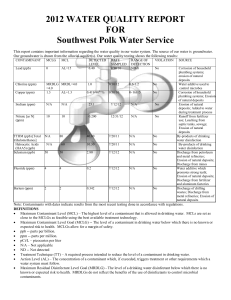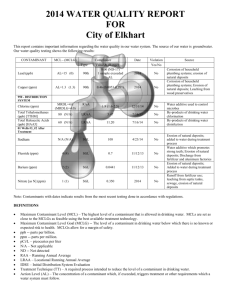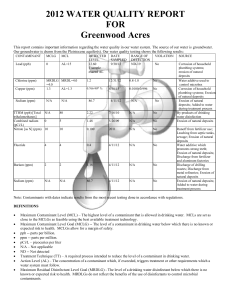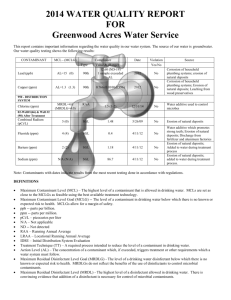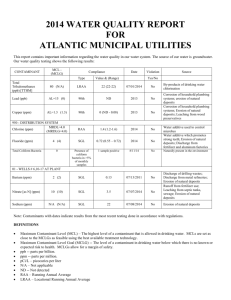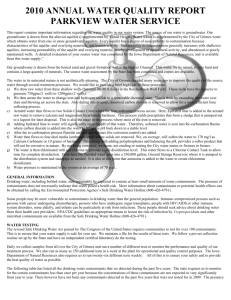Inorganic Contaminants
advertisement
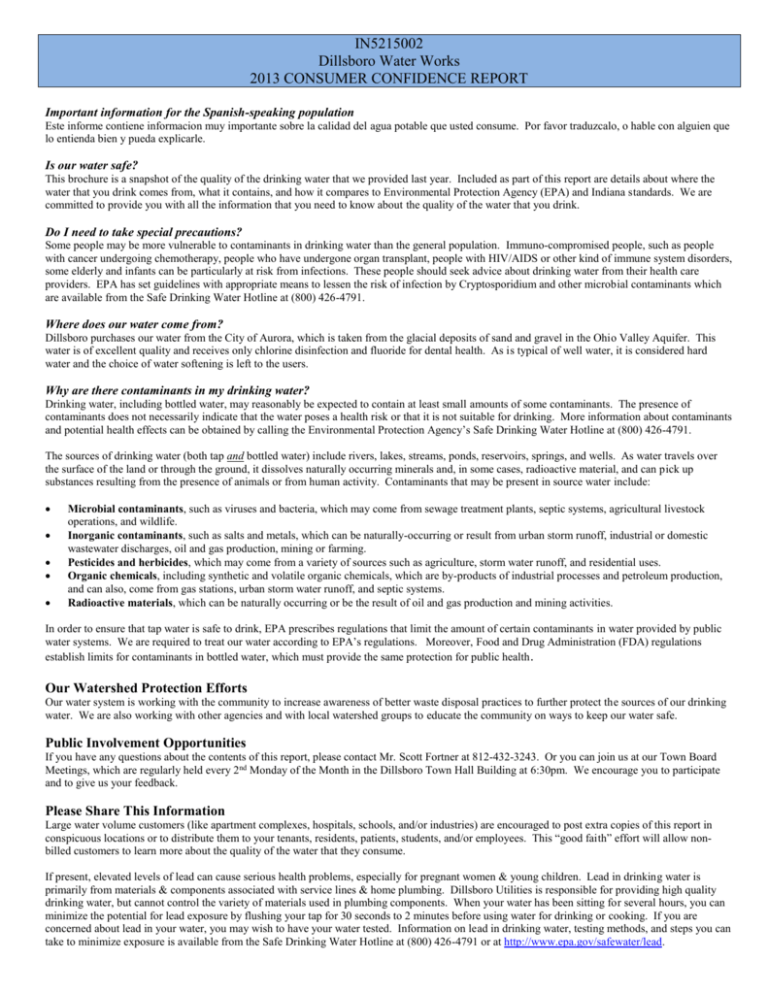
IN5215002 Dillsboro Water Works 2013 CONSUMER CONFIDENCE REPORT Important information for the Spanish-speaking population Este informe contiene informacion muy importante sobre la calidad del agua potable que usted consume. Por favor traduzcalo, o hable con alguien que lo entienda bien y pueda explicarle. Is our water safe? This brochure is a snapshot of the quality of the drinking water that we provided last year. Included as part of this report are details about where the water that you drink comes from, what it contains, and how it compares to Environmental Protection Agency (EPA) and Indiana standards. We are committed to provide you with all the information that you need to know about the quality of the water that you drink. Do I need to take special precautions? Some people may be more vulnerable to contaminants in drinking water than the general population. Immuno-compromised people, such as people with cancer undergoing chemotherapy, people who have undergone organ transplant, people with HIV/AIDS or other kind of immune system disorders, some elderly and infants can be particularly at risk from infections. These people should seek advice about drinking water from their health care providers. EPA has set guidelines with appropriate means to lessen the risk of infection by Cryptosporidium and other microbial contaminants which are available from the Safe Drinking Water Hotline at (800) 426-4791. Where does our water come from? Dillsboro purchases our water from the City of Aurora, which is taken from the glacial deposits of sand and gravel in the Ohio Valley Aquifer. This water is of excellent quality and receives only chlorine disinfection and fluoride for dental health. As is typical of well water, it is considered hard water and the choice of water softening is left to the users. Why are there contaminants in my drinking water? Drinking water, including bottled water, may reasonably be expected to contain at least small amounts of some contaminants. The presence of contaminants does not necessarily indicate that the water poses a health risk or that it is not suitable for drinking. More information about contaminants and potential health effects can be obtained by calling the Environmental Protection Agency’s Safe Drinking Water Hotline at (800) 426-4791. The sources of drinking water (both tap and bottled water) include rivers, lakes, streams, ponds, reservoirs, springs, and wells. As water travels over the surface of the land or through the ground, it dissolves naturally occurring minerals and, in some cases, radioactive material, and can pick up substances resulting from the presence of animals or from human activity. Contaminants that may be present in source water include: Microbial contaminants, such as viruses and bacteria, which may come from sewage treatment plants, septic systems, agricultural livestock operations, and wildlife. Inorganic contaminants, such as salts and metals, which can be naturally-occurring or result from urban storm runoff, industrial or domestic wastewater discharges, oil and gas production, mining or farming. Pesticides and herbicides, which may come from a variety of sources such as agriculture, storm water runoff, and residential uses. Organic chemicals, including synthetic and volatile organic chemicals, which are by-products of industrial processes and petroleum production, and can also, come from gas stations, urban storm water runoff, and septic systems. Radioactive materials, which can be naturally occurring or be the result of oil and gas production and mining activities. In order to ensure that tap water is safe to drink, EPA prescribes regulations that limit the amount of certain contaminants in water provided by public water systems. We are required to treat our water according to EPA’s regulations. Moreover, Food and Drug Administration (FDA) regulations establish limits for contaminants in bottled water, which must provide the same protection for public health . Our Watershed Protection Efforts Our water system is working with the community to increase awareness of better waste disposal practices to further protect the sources of our drinking water. We are also working with other agencies and with local watershed groups to educate the community on ways to keep our water safe. Public Involvement Opportunities If you have any questions about the contents of this report, please contact Mr. Scott Fortner at 812-432-3243. Or you can join us at our Town Board Meetings, which are regularly held every 2nd Monday of the Month in the Dillsboro Town Hall Building at 6:30pm. We encourage you to participate and to give us your feedback. Please Share This Information Large water volume customers (like apartment complexes, hospitals, schools, and/or industries) are encouraged to post extra copies of this report in conspicuous locations or to distribute them to your tenants, residents, patients, students, and/or employees. This “good faith” effort will allow nonbilled customers to learn more about the quality of the water that they consume. If present, elevated levels of lead can cause serious health problems, especially for pregnant women & young children. Lead in drinking water is primarily from materials & components associated with service lines & home plumbing. Dillsboro Utilities is responsible for providing high quality drinking water, but cannot control the variety of materials used in plumbing components. When your water has been sitting for several hours, you can minimize the potential for lead exposure by flushing your tap for 30 seconds to 2 minutes before using water for drinking or cooking. If you are concerned about lead in your water, you may wish to have your water tested. Information on lead in drinking water, testing methods, and steps you can take to minimize exposure is available from the Safe Drinking Water Hotline at (800) 426-4791 or at http://www.epa.gov/safewater/lead. Water Quality Data The table below lists all the contaminants that we detected during the 2013 calendar year. The presence of these contaminants in the water does not necessarily indicate that the water poses a health risk. Unless otherwise indicated, the data presented in this table is from testing done between January 1 and December 31, 2013. The Indiana Department of Environmental Management (IDEM) requires us to monitor for certain contaminants at a frequency less than once per year because the concentrations of these contaminants are not expected to vary significantly from one year to another. Some of the data, though representative of the water quality, may however be more than one year old. Some of the terms and abbreviations used in this report are: MCLG Maximum Contaminant Level Goal, the level of a contaminant in drinking water below which there is no known or expected risk to health. MCL Maximum Contaminant Level, the highest level of a contaminant that is allowed in drinking water. PPM Parts per million, a measurement parameter equal to one part per million parts. PPB Parts per billion, a measurement parameter equal to one part per billion parts. AL Action Level, the concentration of a contaminant which, if exceeded, triggers treatment or other requirements which a water system must follow. PCi/l Picocuries per Liter, a measure for radiation. MRDL Maximum residual disinfectant level, the highest level of disinfectant allowed in drinking water. MRDLG Maximum residual disinfectant level goal, the level of a drinking water disinfectant below which there is no known expected health risk. TT Treatment Technique, a required process intended to reduce the level of a contaminant in drinking water. NTU Nephelometric Turbidity Unit, a measure of the clarity (or cloudiness) of water. P* Potential violation, on that is likely to occur in the near future once the system have sampled for four quarters. n/a either not available or not applicable ND Not Detected, the result was not detected at or above the analytical method detection level. BDL Below Detectable Limit Inorganic Contaminants Date Contaminant MCL MCLG Units Result Min Max Violates Likely Sources Valid until 7/17/2012 Copper (90th Percentile) 1.3 (AL) 1.3 Mg/l 0.271 No Corrosion of household plumbing systems; Erosion of natural deposits; Leaching from wood preservatives Valid until 7/17/2012 Lead (90th percentile) 15 15 ppb 1.1 No Corrosion of household plumbing systems; Erosion of natural deposits 8/25/2011 Chromium 100 100 ppb .002 No 8/19/2011 Mercury 2 2 ppb 0.0003 No 8/11/2011 Fluoride 4 4 ppm .301 No 8/25/2011 Nickel 0 0 ppb .001 No Erosion of natural deposits. Leaching 8/27/2013 Nitrate (as N) 10 10 ppm 0.269 No IN5215001 – Runoff from fertilizer use; Leaching from septic tanks, sewage; Erosion of natural deposits IN5215001 – Discharge from steel and pulp mills; Erosion of natural deposits IN5215001 – Discharge from petroleum and metal refineries, erosion of natural deposits, discharge from mines IN5215001 - Water additive promotes strong teeth; Erosion of natural deposits, discharge from fertilizer and aluminum factories Disinfection Byproducts & Precursors 8/13/2013 8/13/2013 8/27/2013 8/27/2013 Total Haloacetic Acids (haa5) Total trihalomethanes (tthm) Total Haloacetic Acids (haa5) Total trihalomethanes (tthm) 60 ppb 14.1 14.1 14.1 No IN5215002 – By-products of drinking water Chlorination 80 ppb 27.7 27.7 27.7 No IN5215002 – By-products of drinking water Chlorination 60 ppb 4.8 4.8 4.8 No IN5215001 – By-products of drinking water Chlorination 80 ppb 6.1 6.1 6.1 No IN5215001 – By-products of drinking water Chlorination 4 0 Mrom/ yr 1.4 No Decay of natural and man-made deposits 15 0 pC/L 1.2 No Erosion of natural deposits 30 0 Ug/1 .5 No Erosion of natural deposits Radioactive Contaminants 6/17/2008 6/17/2008 6/17/2008 Beta/photon emitters Gross alpha excluding radon & uranium uranium Synthetic Organic Compounds 8/28/2012 27 ppm BDL No Runoff from herbicides No IN5215001- Water additive (disinfectant) used to control microbiological organisms Residual Disinfectant 2010 Chlorine Residual 4 MRDL mg/l 1 1 1


